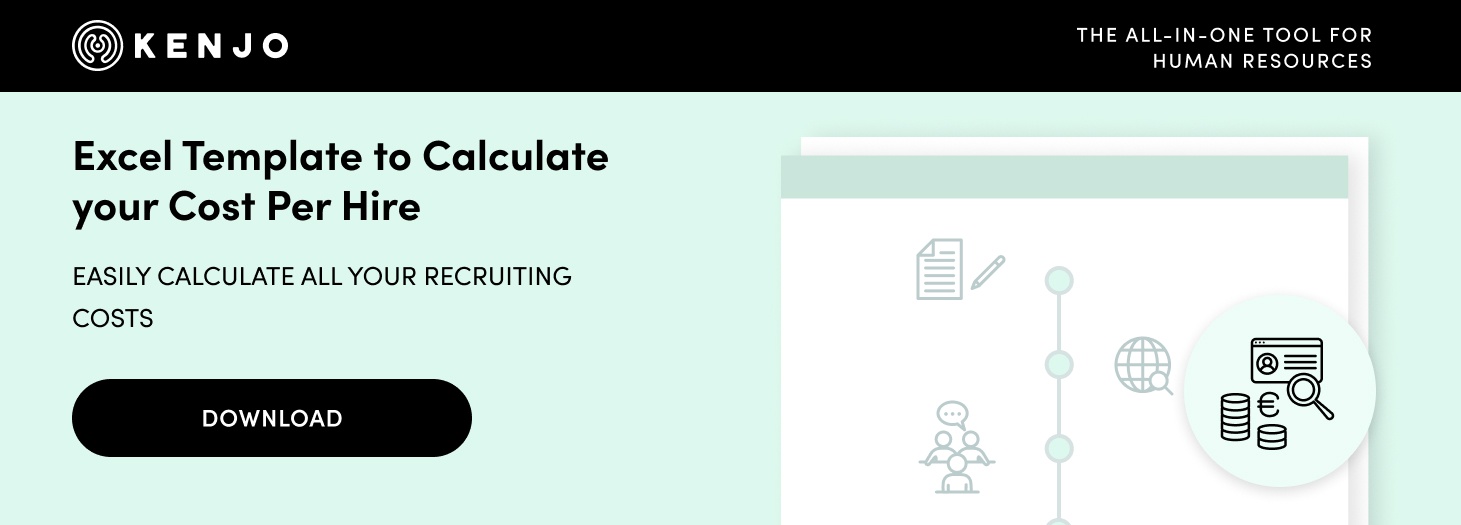What is the cost of recruitment and selection, from the moment a job vacancy opens up or you realise you need another team member, until the position is filled?
If you have ever asked yourself that question and haven’t yet found the answer, keep reading to find out how to calculate recruitment costs.
The importance of making a good hire
Recruitment and selection processes have associated costs, which we will look at in detail in this article. However, on top of this, we mustn’t forget the financial outlay that comes with bad hiring decisions. In fact, choosing the wrong candidate can cost a company dearly.
Here are some statistics from different sources:
- The average cost of a bad hire can be up to 30% of an employee’s first-year earnings.
- 34% of CFOs said that choosing the wrong candidate is harmful to team productivity and forces managers to spend 17% of their time supervising work.
- 74% of companies admit having made a wrong decision when choosing an employee.

How to calculate recruitment costs
To find out how much we are spending on recruitment and selection we need to invest some time calculating all the associated costs (both direct and indirect). To get a realistic figure you will need to go into detail. Let’s review all the elements we will need to put a budget together.
1. Human Resources
The people or recruiters who manage the hiring process of course receive a monthly salary. In general, the ratio is usually one employee per 50 planned hires per year.
If you know how much this person is paid per hour, and the time spent on each hire, you will be able to calculate exactly what it costs you in terms of labour for each time you initiate a new recruitment and selection process.
2. Fixed costs
This category can vary significantly between companies, but these are some of the most common elements:
- Agreements with universities: use the spend from previous years in this area as a reference to estimate what it may cost to find student or recent graduate talent.
- External recruitment agencies: many companies decide to subcontract their recruitment needs. If this is the case, include agency fees in the budget.
- Recruitment fairs: if you are attending an event or job fair, include the registration fee, as well as your employees’ food and accommodation allowances.
3. Recruitment technology
If you use any software or tools, include them in the budget. Don’t forget assessment tools, applicant tracking systems (ATS), video conferencing apps for online interviews, etc. Any technology that you use that has a cost attached should be included.

4. Process improvements
The hiring cost may also include additional extras to extend the selection process and obtain more information on the candidates. For example, you may wish to allocate budget for assessments such as psychometric tests or group interviews.
5. Miscellaneous costs
Include any other cost that arises during the hiring process. Maybe you need to add on printing costs for flyers to hand out at a job fair, or travel costs for a particularly desirable candidate to attend an interview.
6. Calculate the cost per hire
One of the recruiting KPIs is the cost per hire. Or, in other words, how much the company has to invest to find an employee to fill a job opening. Being aware of this metric will give you better control over the department budget.
Calculate it using the following formula:
(Internal costs + External costs) / Total hires.
Internal costs refer to the activities carried out by the company itself (HR salaries, for example) and external are all those that have been paid out to third parties (adverts, tools, etc).

How do you optimise recruitment costs?
While every selection process will always involve some cost, there are some ways companies can reduce or get the most out of their investment. Here are a few examples:
- Bear in mind the essential recruiting KPIs to identify areas for improvement. For example, you could analyse your recruitment sources and select the ones that are generating high quality candidates. This will save you time and money.
- Automate manual work. Technology can help you reduce or even eliminate the time you spend on repetitive tasks. And, as you well know, time is money. For example, according to one study, companies who use automated CV screening have reduced their average time to hire by 75%.
- Use an all-in-one tool. It works out much more expensive to use one tool for recruitment and another for tests and assessments, etc. Always look to integrate and reduce the number of solutions as far as possible.
- Don’t pay for your adverts on job portals if you don’t need to. There are many free ways to attract talent, including free-of-charge platforms that work very well.
- Work on your employer branding over time to help you attract talent more easily. This way, you will not need to invest the same mammoth effort for every hire. According to Linkedin, companies on their platform with a strong talent brand spend, on average, 43% less to make a hire.
- Look after your employees and promote a positive working environment. This will lower your turnover rate and drastically reduce the total number of selection processes. Send out surveys and follow up periodically to ensure all is well with your teams.



